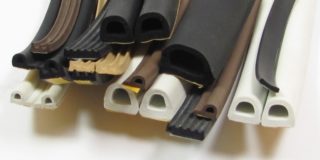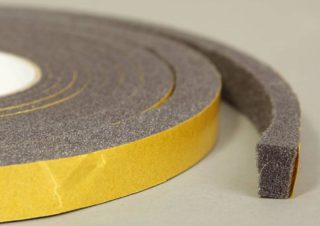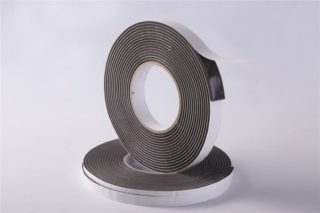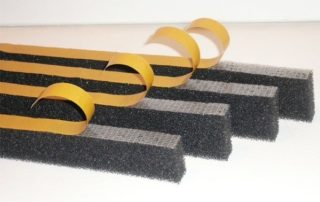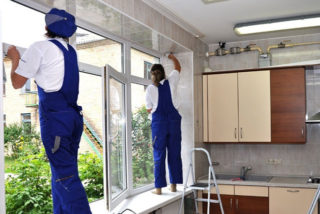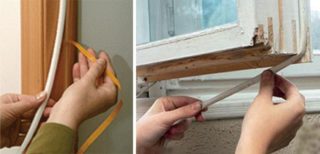Window openings are insulated regularly, so the complexity and cost of the procedure is important. Insulation for windows based on self-adhesive tape makes the task easier. The sealant is produced from different materials, each type has advantages and disadvantages. Special tools can serve as thermal insulation for several years if the technology of work is followed.
A variety of types of insulation
The design of self-adhesive insulation for windows consists of an insulating base and an adhesive base. The sealant is produced by foreign and domestic firms.
In stores, brands are available for sale:
- Profitrast. Tapes are made of foam rubber, resistant to destruction from temperature extremes, sunlight. Closed micropores in the structure protect against penetration of air and moisture at -50 - + 70 ° С.
- Econ. Products are produced with the best combination of quality and value. Adhesive materials are easy to use and comply with Henkel's traditions and standards.
- Kimtek. Seals are used for windows made of metal, wood and plastic, there is a choice of size and type of insulation strip.
- Bison Prevents drafts, dust and sounds. Products do not shrink over time, resist cracking, drying out, mold does not appear on the surface.
- Deventer The contour is intended for wooden windows and doors. The manufacturing company pays attention to product quality and uses proprietary raw materials.
- Sanok. The tape for warming is used at external temperatures from -60 to + 120 ° C. The structure of the seal makes it inaccessible to moisture, which increases the thermal insulation characteristics. The material does not oxidize and reacts steadily to the action of chemicals.
Russian and foreign manufacturers use different raw materials in the production process, the quality of the insulator depends on this.
Foam rubber
The material is an elastic polyurethane foam in the form of a hardened foam containing 90% air. Elastic insulation effectively resists heat loss through window slots and has low vapor permeability.
Properties of window insulation made of foam rubber:
- does not emit harmful components into the environment when used in normal conditions;
- when compressed, it deforms without changing the structure and geometric parameters;
- the weight of foam rubber is determined by the size of the air cells in order to insulate the openings, a density of 25 - 35 kg / m3 is used;
- the compressive strength is 120 - 140 kPa, the relative elongation at break ranges from 245 - 285%;
- under the influence of cold air, the elasticity of the material decreases, but is restored when the temperature rises, the change in thermal conductivity is affected by moisture in the material;
- high-density foam rubber has almost no residual deformation, the sealant with low rates quickly fails.
The disadvantages of foam rubber include a short service life, because over time, the material crumbles, sticks together and loses elasticity. The heater releases harmful substances during a fire and quickly ignites.
Polyvinyl chloride
Using PVC sealing loops, it is possible to insulate wooden frames and plastic windows. This material has greater strength and durability than foam.The heat insulator is produced using foamed mixtures of resin, rubbers and plasticizers, it belongs to the porous types.
Properties of PVC-based insulation tape:
- density is 0.135 - 0.140 kg / m3;
- it resists the action of mineral oils, solvents, acids, alkalis, salts, fats, is destroyed by contact with tetrahydrofuran, cyclohexanone, swells in acetone and benzene;
- works in the temperature range - 15 - + 66 ° С;
- ultimate bending strength - 80 - 120 MPa, tensile - 40 - 50 MPa.
A low frost tolerance threshold is a disadvantage of PVC tape. The material has low elasticity and after deformation it is difficult to restore shape and size, therefore, requires annual replacement.
When heated, the sealant releases harmful components into the air. The insulation is destroyed under the influence of sunlight.
Polyethylene foam
The material is obtained by processing polyethylene under high pressure with the addition of flame retardants, dyes and hydrocarbon compounds. As a result of extrusion, foamed polyethylene is obtained, the structure of which is represented by insulated shallow voids.
Properties of self-adhesive insulation of their PES:
- thermal conductivity at the level of 0.0037 W / m · K allows you to qualitatively isolate the gap from the ingress of cold flows;
- low ability to absorb moisture provides heat-protective qualities of the material in rainy weather;
- the melting point of polyethylene foam is + 120 ° C;
- the material is not destroyed by contact with various chemicals, aggressive media, mold does not appear on the surface and in the mass.
The elastic seal is suitable for use in small crevices, as restores the original size and shape. Foam tape seal serves up to 5 years without loss of quality.
Rubber
The insulation is made on the basis of synthetic rubber by vulcanization of raw materials with the addition of sulfur impurities. Adhesive-based rubber seals operate at temperatures ranging from -50 ° C to + 100 ° C.
Material Properties:
- resists the action of gasolines, oils and other petroleum products;
- soft rubber is used to seal the windows, which has a density of up to 50 kg / m3;
- does not pass vapors and air;
- cracks and swelling do not form in the thickness;
- differs in high indicators of wear resistance in relation to chemical and mechanical action;
- the compressive strength is 5-35 MPa, the material can be extended by 100 - 220% without loss of properties.
The life of a rubber insulation is determined by the use of active fillers in the production process and the quality of the feedstock. Tape for windows is available in round or oval shapes of different diameters.
Characteristics of insulation for windows
Tape for window insulation is made on a self-adhesive basis or without it. The first type is more often used for insulation of openings, because installs simply. For the second variety, glue is used, which is additionally applied to the surface of the frame to fix the elastic strip.
The disadvantage of a sealant without a self-adhesive base is that the user uses a random adhesive that leaves traces of hard to remove on the frame. And the manufacturer of the circuit with the base uses a composition that does not leave marks. The complexity of installing a self-adhesive window insulation is markedly reduced.
Advantages and disadvantages
The positive aspects of the application are effective insulation from the cold at an affordable cost of material. The sealant can be installed in 2 layers, which improves the quality of protection.The insulation tape at the same time isolates the room from blowing, noise, humidity and dust.
The circuit is put into the mounting position quickly, but requires pre-treatment of gluing points. Without preparation, the tape peels off the surface of the frame when opening the window or sash.
The disadvantages are that not all materials have a low ability to accumulate moisture. For example, it is better not to put foam on the outer wings, so that in the rain the seals do not lose their protective characteristics.
Preparing frames and glasses for insulation
The location to install the circuit is selected. The tape is placed so that the position of the adhesive base corresponds to the plane of the frame glass. The sealant is attached to the part of the opening where the transom is pressed. Double warming is practiced, when one tape is glued to the frame, and the second is placed on the pressure plate of the sash.
Preparation Procedure:
- the remains of the old material are removed, the surface of the frame and transom in the places of installation of the sealant is cleaned;
- if the tape is glued at the junction of the frame and glass, the glass and the contact area of the sash are cleaned;
- degrease the surface with alcohol to increase adhesion.
A thin sealant is bought for small gaps, and large gaps are protected by thick and wide ribbons. The perimeter of the installation sites is measured, depending on this, the total footage is taken.
DIY installation instructions for windows
A tape measure measures the length of a piece and is cut from a roll. The protective layer is removed from the tape gradually, as it is glued. You can not simultaneously clear all pieces of the protective coating, because the sticky layer becomes dusty or dry. The tape is pressed to the surface, additional use of a hair dryer or roller is not required.
The following pieces are measured and cut off after fixing the previous sections. The sealant is glued without tension, at the corners the tape can be wrapped, and not cut off. Work is carried out in the fall, when there are no severe colds on the street that negatively affect the process. The adhesive has a drying time of 2 hours, after which the shutters close.
